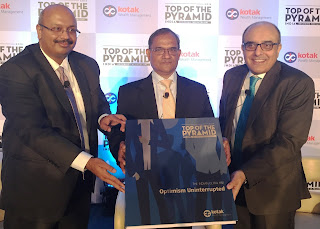Kotak Wealth Launches Sixth Edition of Top of the Pyramid Report - Ultra HNIs ‘Optimism’ continue ‘Uninterrupted’
 |
Mumbai, July 26, 2016: Kotak Wealth Management (KWM), today, announced the launch of the sixth edition of its ‘Top of the Pyramid’ (TOP 2016) report. The report offers insights on earning, spending and investing patterns of India’s UHNIs. The theme of the report - ‘Optimism Uninterrupted’, aptly captures the positive mood of the economy, increase in consumption and uninterrupted spending by UHNIs.
TOP 2016 offers interesting insights into the world of UHNIs. UHNHs in India have increased by 7% to approximately 146,600 in FY16, a compounded annual growth rate of 16% over the previous five years. They represent an accumulated net worth of Rs. 135 trillion, a growth of 5% over last year and 18% compounded growth over the last five years. Interestingly, 45% of the UHNHs are based out of emerging cities and small towns. The report is forecasting further wealth creation in the country. Number of UHNHs is estimated to increase to 294,000 by FY 2021 with a combine net worth of Rs. 319 trillion.
Wearable devices such as smart watches, fitness bands, virtual reality headsets, and head phones are becoming popular with a whopping 81% seeing these devices as a status symbol. Almost 57% UHNIs have incorporated them as part of their lifestyle. Contrary to popular assumptions, a very high adoption rate of 61% was observed in the 36 – 50 age group, rather than those below 35.
Nearly 98% of UHNIs believe that succession planning is a continuous and proactive process. They often choose children and high potential family members as the pool of potential successors. Though trusts are gaining traction, wills are the most common instrument of choice. Most visit their succession plan at least once in five years.
Interestingly, impact investment is new flavour of 2015. This space is receiving traction based on attractiveness of sector, stability of returns, and the will to make a sustainable difference to people’s lives. Inclination is to invest in the core sectors of financial services, affordable housing clean energy, and renewable energy such as solar power, bio and wind. Typical investments were below Rs. 50 lakh for financial services and clean energy, and up to Rs. 1 crore for affordable housing.
Dipak Gupta, Joint Managing Director, Kotak Mahindra Bank Limited, said, “What an exciting year 2015 has been! India emerged as one of the strongest larger economies in the world, despite bumps such as the stress in the banking sector and a choppy stock market performance. For UHNIs, last year’s positivity flowed through into this year with reforms taking root, inflation under control, and economic growth looking up. TOP 2016 captures the mood of the UHNIs in India in the context of the country’s changing socio-economic landscape.”
Murali Balaraman, Partner – Advisory Services, Ernst & Young, said, “Top of the Pyramid 2016 has been prepared through interactions with over 225 ultra HNIs across twelve Indian cities. Overall, the investment mood has remained positive. The rate cuts have led to fall in lending rates resulting in improved ultra HNI sentiment and increased investments into primary businesses. Two interesting findings in lifestyle – Firstly, UHNIs continue to spend high across jewellery, apparel & accessories, holidays and thus seem pretty much unaffected by global uncertainty, secondly ultra HNIs are increasingly getting involved in Renewable energy initiatives – be it on the investment side or even embedding it into their daily life. It will be interesting to see how this trend pans out in the near future.”
TOP 2016 points out that equity found less favour amongst ultra UHNIs this year, because of subdued performance, which in turn lead to a corresponding rise in other asset classes such as real estate, debt and alternate assets. UHNI investments across asset classes in FY16: equity - 39%, real estate - 28%, debt – 22% and alternate investments - 11%. Commercial properties were the biggest and most stable attraction in the real estate market.
Commodity investments too are gaining confidence of UHNIs, with nearly 72% of them invested in this asset class. Gold and silver continue to be the most preferred metals. Physical buying is the preferred purchasing method for 80% of ultra HNIs investing in gold and 74% of those investing in silver. However, for energy-based commodities, more than half invest directly through exchanges, online portals, and brokers.
Amongst luxury spends, jewellery and apparel continue to remain top spending category for UHNIs. Branded luxury remains the most important driver in choices for apparels, including weather specific choices in clothing. India is a preferred destination to shop, followed by Dubai, Singapore and Europe. Passion and status are also driving investments of UHNIs’ into art and paintings as an integral component of their portfolio. UHNIs also define their quest for luxury and power by investing in collectibles such as vintage cars, sculptors, antiques and curios. This fulfils their desire to be exclusive and distinct.
‘Top of the Pyramid 2016’ is based on in-depth interviews with luxury service providers and extensive market research with 225 ultra HNIs across multiple cities. The report can be downloaded from the Kotak Wealth Management websitewww.wealthmanagement.kotak.com.


Comments
Post a Comment